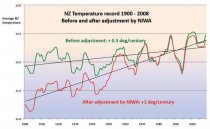By Paul Joseph Watson
An article carried by the official Greenpeace website written by a Greenpeace member urges climate activists to resort to criminal activity in an effort to reinvigorate momentum for their stalling global warming agenda, while ominously threatening climate skeptics, “we know where you live”.
The article, written by Greenpeace activist “Gene” from India, calls for “mass civil disobedience to cut off the financial oxygen from denial and skepticism”.
“Gene” then has a special message for roughly half of Americans who, in the wake of the climategate scandal, are now skeptical of man-made global warming - “We know who you are. We know where you live. We know where you work. And we be many, but you be few.”
“Gene” quotes another climate activist who calls for an army of greenies to break the law and take retribution against anyone who stands in their way.
“The politicians have failed. Now it’s up to us. We must break the law to make the laws we need: laws that are supposed to protect society, and protect our future. Until our laws do that, screw being climate lobbyists. Screw being climate activists. It’s not working. We need an army of climate outlaws.”
Greenpeace has not issued a retraction of the comments, preferring instead to buffer the blog at both beginning and end with desperate-sounding explanations insisting that the author has peaceful intentions. The organization has obviously been taking a hammering for this as it worsens into another public relations disaster.
This is by no means the first time global warming adherents have resorted to physical threats in an effort to bolster their rapidly crumbling credibility on climate change issues. In June last year, a global warming activist posted an article on the Talking Points Memo website entitled “At What Point Do We Jail Or Execute Global Warming Deniers?”
Shortly after the article was retracted, a comment traced back to another prominent global warming activist which appeared on the Climate Progress blog threatened Skeptics that “an entire generation that will soon be ready to strangle you and your kind while you sleep in your beds.” Website owner Joe Romm defended the comment as “clearly not a threat but a prediction”.
For years, climate Skeptics have been the target of campaigns to denounce them as criminals and traitors on the scale of the Nazis, with calls for Nuremberg trials. A July 2007 Senate report detailed how skeptical scientists have faced threats and intimidation.
“Is this really the kind of caring, sensitive message this charity ought to be conveying to the world?” asks James Delingpole. “Not to judge by the comments below. Happy Easter, Greenpeace PR department! I think you’re going to have a busy next few days...”
As a recent Psychological Science study highlighted, warmists tend not to adhere to the caring, sensitive image they portray when it comes to their own private lives.
“Those who wear what the authors call the “halo of green consumerism” are less likely to be kind to others, and more likely to cheat and steal,” summarizes the Telegraph’s Iain Hollingshead. “Faced with various moral choices - whether to stick to the rules in games, for example, or to pay themselves an appropriate wage - the green participants behaved much worse in the experiments than their conventional counterparts. The short answer to the paper’s question, then, is: No. Greens are mean.”
Despite Greenpeace’s efforts at damage control, there can be little doubt as to the true context of the article. By first encouraging climate activists to “break the law” in pursuit of their stalling political agenda, “Gene” has greased the skids for criminal activity. Concluding with the threat to climate Skeptics that “we know where you live,” is clearly a form of intimidation and an invitation for “an army of climate outlaws” to take physical retribution against people who disagree with them.
Imagine if Infowars put out an article urging its readers to break the law in order to combat the IRS, imagine if we told IRS agents, “we know where you live”. We’d be raided quicker than a heartbeat and Alex Jones would be demonized all over the establishment media as a dangerous extremist. Indeed, a mere peaceful letter-writing campaign urging governors to resign was leapt upon by the media and the federal government this past weekend as a concerning portend of the “extremist” threat posed by constitutionalists despite the fact that there was no indication of violence.
When so-called “right-wingers” or libertarians merely write letters urging peaceful political change, they are demonized as terrorist hate-mongers, but when greenies openly call for criminal behavior allied with thinly veiled threats of physical violence, it’s no big deal.
Will CNN and MSNBC devote weeks of endless coverage to Greenpeace’s threats towards people they disagree with? There’s more chance of Keith Olbermann awarding Rep. Hank Johnson (a major global warming adherent) his “worst person in the world” gong for hilariously warning that the island of Guam could capsize like a boat due to overpopulation. See post here.
See more stories on how the UN plans to make another run at using climate change to achieve its goal of one world government, how green jobs are failing and much more here.
----------
Microbes ate BP oil deep-water plume: study
By Deborah Zabarenko, Environment Correspondent
WASHINGTON, Aug. 24, 2010 (Reuters) - A Manhattan-sized plume of oil spewed deep into the Gulf of Mexico by BP’s broken Macondo well has been consumed by a newly discovered fast-eating species of microbes, scientists reported on Tuesday.

This undated handout image shows microbes (C) degrading oil (upper right) in the deepwater plume from the BP oil spill in the Gulf, a study by Berkeley Lab researchers has shown.
The micro-organisms were apparently stimulated by the massive oil spill that began in April, and they degraded the hydrocarbons so efficiently that the plume is now undetectable, said Terry Hazen of Lawrence Berkeley National Laboratory.
These so-called proteobacteria—Hazen calls them “bugs”—have adapted to the cold deep water where the big BP plume was observed and are able to biodegrade hydrocarbons much more quickly than expected, without significantly depleting oxygen as most known oil-depleting bacteria do.
Oxygen is essential to the survival of commercially important fish and shellfish; a seasonal low-oxygen “dead zone” forms most summers in the Gulf of Mexico, caused by farm chemical run-off that flows down the Mississippi River.
Hydrocarbons in the crude oil from the BP spill actually stimulated the new microbes’ ability to degrade them in cold water, Hazen and his colleagues wrote in research published on Tuesday in the journal Science.
In part, Hazen said, this is because these new “bugs” have adjusted over millions of years to seek out any petroleum they can find at the depths where they live, which coincides with the depth of the previously observed plume, roughly 3000 feet. At that depth, water temperature is approximately 41 degrees F (5 degrees C).
FEASTING ON HYDROCARBONS
Long before humans drilled for oil, natural oil seeps in the Gulf of Mexico have put out the equivalent of an Exxon Valdez spill each year, Hazen said.
Another factor was the consistency of the oil that came from the Macondo wellhead: light sweet Louisiana crude, an easily digestible substance for bacteria, and it was dispersed into tiny droplets, which also makes it more biodegradable.
These latest findings may initially seem to be at odds with a study published last Thursday in Science by researchers from Woods Hole Oceanographic Institution, which confirmed the existence of the oil plume and said micro-organisms did not seem to be biodegrading it very quickly.
However, Hazen and Rich Camilli of Woods Hole both said on Tuesday that the studies complement each other.
The Woods Hole team used an autonomous robot submarine and a mass spectrometer to detect the plume, but were forced to leave the area in late June, when Hurricane Alex threatened. At that time, they figured the plume was likely to remain for some time.
But that was before the well was capped in mid-July. Hazen said that within two weeks of the capping, the plume could not be detected, but there was a phenomenon called marine snow that indicated microbes had been feasting on hydrocarbons.
As of Tuesday, there was no sign of the plume, Hazen said.
That doesn’t mean there is no oil left from the 4.9 million barrels of crude that spilled into the Gulf after the April 20 blowout at BP’s Deepwater Horizon rig. The U.S. government estimated on August 4 that 50 percent of the BP oil is gone from the Gulf and the rest is rapidly degrading.
Read more here.
ICSC
September 7, 2010: Critical Pacific Ocean subset of UN Intergovernmental Panel on Climate Change (IPCC) temperature data now to be examined by New Zealand High Court.
In what is believed to be the first case of its kind in the world, the newly formed New Zealand Climate Science Education Trust has taken legal action against the National Institute for Water and Atmospheric Research (NIWA), a ‘Crown Research Institute’ contracted by the NZ Government to be its sole adviser on scientific issues relating to climate change. Instead of using the New Zealand Met Service temperature record that shows no warming during the last century, NIWA has adopted an “adjusted” record of seven surface stations that shows a 1 deg. C rise, almost 50% above the global average for that period.

Enlarged here.
Because there are very few long term temperature records in the Pacific Ocean, the NIWA record bears heavily disproportionate weight in determining multi-decadal trends in global average temperatures used by the UN Intergovernmental Panel on Climate Change. However, the basis for the NIWA temperature adjustments is unknown, the data and calculations that underlie the adjustment method lost, and the originator of the technique of adjustment summarily dismissed from his position at NIWA.
Read news release from ICSC affiliate, the New Zealand Climate Science Coalition (NZCSC), which has unsuccessfully sought access to the data and calculations behind the temperature adjustment since 2006.
Read November 2009 NZCSC paper on the scandal, ”Are We Feeling Warmer Yet? ”, by Barry Brill, OBE.
Read May 2010 response to NIWA attempts to whitewash the affair.
Due to the international significance of this case, ICSC will keep readers up to date as this legal action unfolds. Read more on the NZCSC Home page.
See ICSC home page here.
By Howard Blume, Los Angeles Times
He’s the first vice president to have an L.A. school named after him, sharing the honor with author Rachel Carson. Fittingly, the campus will be devoted to environmental themes. But there’s a catch.
Al Gore has had some tough breaks - like losing the presidency after getting more votes than the other guy - but the noted environmentalist achieved a singular honor last week, becoming the first vice president to have a Los Angeles school named after him.
And, fittingly, the school will be devoted to environmental themes.

But as in the 2000 election, there’s a catch. Critics say the campus’ location poses a long-term health risk to students and staff. School district officials insist that the Arlington Heights property is clean and safe. And they’ve pledged to check vapor monitors and groundwater wells to make sure.
The $75.5-million Carson-Gore Academy of Environmental Sciences will open Sept. 13 for about 675 students. As he was with Bill Clinton (who has an L.A. middle school named after him), Gore is second on the ticket to Rachel Carson, the late author credited with helping launch the modern environmental movement.
“Renaming this terribly contaminated school after famous environmental advocates is an affront to the great work that these individuals have done to protect the public’s health from harm,” an environmental coalition wrote in a letter to the Los Angeles Unified School District. Making sure the school is safe “would be an even better way to honor their contribution to society.”
Construction crews were working at the campus up to the Labor Day weekend, replacing toxic soil with clean fill. All told, workers removed dirt from two 3,800-square-foot plots to a depth of 45 feet, space enough to hold a four-story building. The soil had contained more than a dozen underground storage tanks serving light industrial businesses.
Additional contamination may have come from the underground tanks of an adjacent gas station. A barrier will stretch 45 feet down from ground level to limit future possible fuel leakage.
An oil well operates across the street, but officials said they’ve found no associated risks. Like many local campuses, this school also sits above an oil field, but no oil field-related methane has been detected. Groundwater about 45 feet below the surface remains contaminated but also poses no risk, officials said.
Because the district imported clean dirt, the school is probably safe at the moment, said Jane Williams, executive director of the Kern County-based California Communities Against Toxics. But she and other critics, including Robina Suwol, who heads the locally based California Safe Schools coalition, worry that the pollution sources have not been adequately identified and that the dirty groundwater could recontaminate the soil.
Everything’s under control after the $4-million cleanup, said John Sterritt, the school system’s chief safety officer. “There’s no doubt in my mind that the site is safe, and if there are any changes, our monitoring or our existing processes will detect it and we’ll react to that,” Sterritt said. “We really go out of our way to make sure these properties are safe.”
Officials contend the district has made huge strides since environmental concerns stalled the Belmont Learning Complex, which has since opened as the Roybal Learning Center. In addition, new schools now fall under the review of the state Department of Toxic Substances Control.
In the spring, a school-naming committee received six options, including Pete Seeger Community School. A representative from school board member Marguerite Poindexter LaMotte suggested that the folk singer’s “affiliation with the Communist Party,” among other factors, made that choice inappropriate, two in attendance recalled.
Three meetings later, the consensus was Carson-Gore. At last week’s school board meeting, district officials said Gore had never been contacted regarding the naming or the contamination concerns. Board member Nury Martinez speculated that, under the circumstances, Gore might decline the honor.
But school Principal Kurt Lowry pointed out that no one obtained Barack Obama’s permission before naming a middle school (also opening this fall) after the president. Lowry intends to invite Gore and members of Carson’s family to the school’s October ribbon-cutting.
Gore is on vacation and unreachable, said spokesman Mike Feldman. But his staff is not aware of another school named after the former vice president, who raised awareness about global warming in the film “An Inconvenient Truth.” Lowry said the school’s environmental emphasis will do Gore proud, including recycling projects and research and beach cleanups. Cross-curriculum efforts will include environmental speeches and presentations in English, topsoil measurements in math and climate study in science.
The principal also envisions an organic garden that could produce a student-led farmer’s market. Suwol said Lowry sounds “incredibly wonderful,” but added that she’d feel better if the vegetables were grown in planters above the ground. See more here.
---------
Tale of Two Houses
House #1 A 20 room mansion (not including 8 bathrooms) heated by natural gas. Add on a pool (and a pool house) and a separate guest house, all heated by gas. In natural gas alone, this property consumes more than 20 times the national average for an American home. This house is not situated in a Northern or Midwestern “snow belt” area. It’s in the South.

House #2 Designed by an architecture professor at a leading national university. This house incorporates every “green” feature current home construction can provide. A central closet in the house holds ; geothermal heat-pumps drawing ground water through pipes sunk 300 feet into the ground. The water (usually 67 degrees F.) heats the house in the winter and cools it in the summer! The system uses no fossil fuels such as oil or natural gas and it consumes one-quarter of the electricity required for a conventional heating/cooling system.

#1 is outside of Nashville , Tennessee ; it is the abode of the “environmentalist” Al Gore.
#2 is on a ranch near Crawford, Texas ; it is the residence the of the last President of the United States , George W. Bush, reviled by environmentalists.


